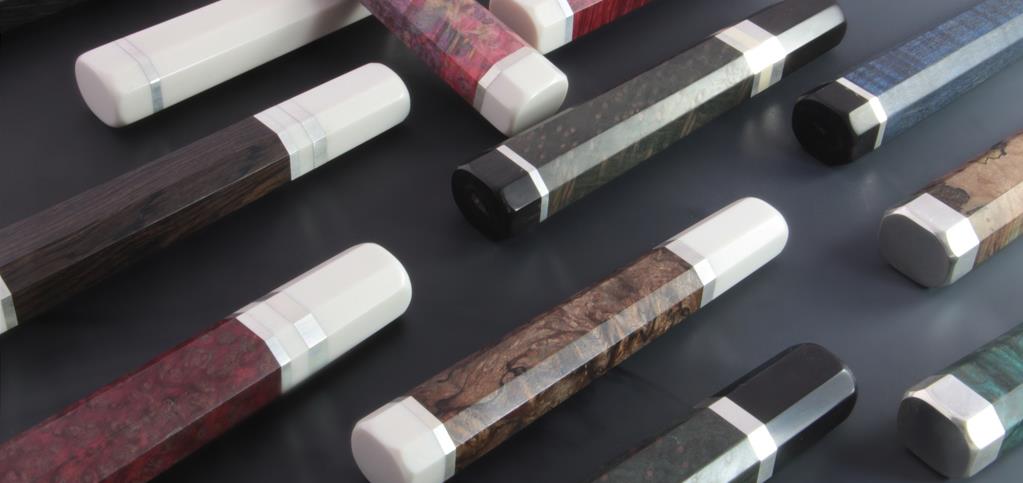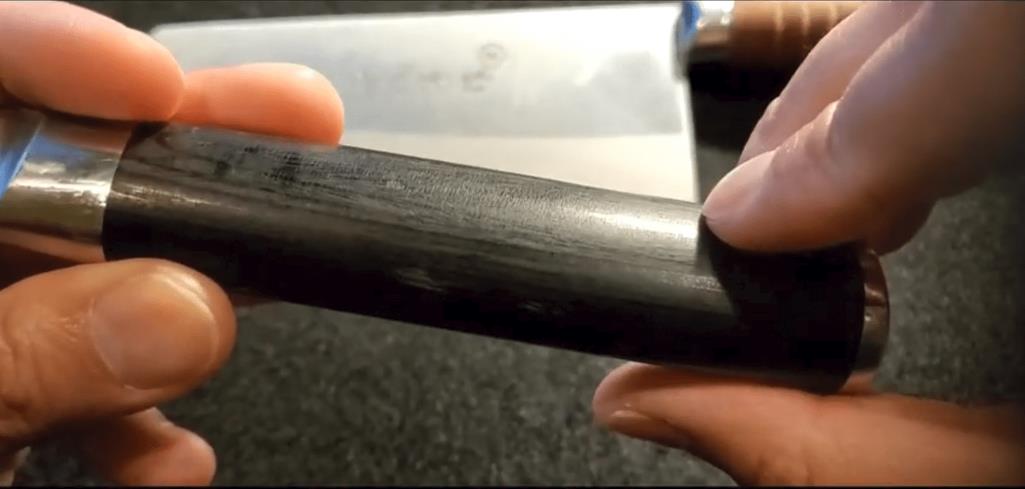If you have been shopping for a new knife recently, you may have come across a strange new word: pakkawood. Clearly, this is some kind of material used in knife handles. But how is it made and what are its physical properties? More importantly, why should you consider buying a knife with a pakkawood handle?
Pakkawood is a composite material that comprises wood veneers impregnated with resin to give excellent water-resistant and anti-bacterial properties. It is durable, comfortable to grip, and has a beautiful natural pattern that can take on numerous colors.
Pakkawood is not only useful for making knife handles. You can also find utensils, razors, and musical instruments made with this material.
This article will give you all the key information about this interesting material, including the manufacturing process and maintenance tips. Hopefully, by the end, you will know whether or not pakkawood lives up to its hype and whether a pakkawood knife handle is for you.
Table of contents
What is pakkawood?

Pakkawood is a composite material that has burst onto the kitchen scene in recent years. It is a very popular material choice for making good-quality knife handles as well as other utensils. Users love pakkawood for its smooth and natural appearance as well as its strong material properties.
Appearance
The typical appearance of pakkawood is a very dark and rich color similar to some hardwood handles. Unlike plain wooden handles though, pakkawood gives off a very beautiful shine.
Dark brown/black is indeed the dominant color of pakkawood, but this material is absolutely not limited to a single shade. By using dyes, manufacturers can create pakkawood with many different colors, from light yellow to orange and purple.
Despite the addition of resin, pakkawood handles retain their stunning natural patterns. Indeed, one reason why they are loved so much is that they have the authentic appearance of wooden handles without suffering from the same physical weaknesses.
Properties
Pakkawood is essentially a mixture of hardwood veneers and phenolic resin. As a composite material, it is not found anywhere in nature, rather, it is specially engineered wood with optimum mechanical properties.
The main benefit of combining resin with wood is that the resin fills the natural pores and cracks present in a piece of wood. This makes the wood far more impermeable to water and bacteria. It also ensures that the wood is less likely to warp at high temperatures or wear down from repeated use. A disadvantage of a wood resin composite is that it is somewhat brittle.
Overall, pakkawood is a dense and durable material. Thanks to the texture of the wood, it is easy to grip despite being fairly smooth. As you will see later, adding resin to wooden handles makes them perform extremely well in cooking applications.
Manufacture
The origin of the name is unclear, but the word “pakka” approximately means “package” in some Scandinavian languages. This is sensible since pakkawood consists of many layers of wood and resin packed together into a single piece of material.
The manufacturing process consists of stacking many thin wooden layers together with resin in-between. The resin serves both as glue and a sealant. Manufacture takes place in a high-pressure environment to ensure that a single solid block is formed with the resin filling all existing gaps.
Once the composite block has hardened and cooled, craftsmen (or machines) can carve specific shapes to produce knife scales, utensils, and other objects.
Pakkawood uses

What has made pakkawood famous is its use in kitchen knife handles. Both western- and Japanese-style knives are available with pakkawood handles nowadays. The smooth and colorful appearance of pakkawood separates it from standard wooden handles. So how does a pakkawood handle compare to other knife handles?
Advantages of a pakkawood handle
- Pakkawood is well protected against heat and moisture, both of which are unavoidable in a kitchen. While standard wooden handles can warp and absorb moisture, a sealed pakkawood handle will remain waterproof and rigid throughout its lifespan.
- Pakkawood is very hygienic. It is food safe, which means it will not contaminate any foods that you prepare. This is a potential danger of knives with cheap plastic handles ― fragments of plastic could break off and spoil your meal. The resin in pakkawood also prevents bacteria from spreading throughout the handle.
- While some synthetic handles have similar material properties to pakkawood, they do not offer users the comfort and texture of a natural handle. Pakkawood has the perfect balance of strength, comfort, and grip.
Disadvantages of a pakkawood handle
- Phenolic resin has many physical benefits for a wooden handle. However, once the resin hardens within, the handle becomes slightly brittle which means it cannot absorb very much energy without cracking. In this regard, a pure metal or polymer knife handle performs better. If you drop them, they are unlikely to shatter.
- Some varieties of natural wood are anti-bacterial. Therefore, having an unprotected wooden handle is not necessarily unhygienic. Some knife enthusiasts might prefer the feel of a standard wooden handle without added resin.
Handpicked for you
True cutting power in the palm of your hand
Pakkawood kitchen utensils

As well as being great for knife handles, pakkawood is very good for making complete utensils. Spoons and forks carved out of this gorgeous wood make a great addition to your dining table and a refreshing change from the usual silver cutlery. You can choose from a range of lovely bright colors and eat your meals with much more ergonomic tools than standard metal cutlery.
Because pakkawood is very safe, you can eat directly from pakkawood utensils without any worries. These utensils are also easy to clean.
Pakkawood razor blades
An unexpected but very useful application of pakkawood is in razor blade handles. A bathroom environment is warm and humid much like a kitchen, and pakkawood performs very well in these conditions. You can find traditional single-blade razors on sale with pakkawood handles. These razors offer supreme cutting performance with a solid and comfortable handle ― just like many pakkawood kitchen knives.
Other applications of pakkawood
Kitchen knives, utensils, and razor blades are just a few items that make use of pakkawood’s excellent properties. Some bowls and jars are made with this type of wood too. Away from the kitchen, you might also see some hunting knives that feature pakkawood handles.
One totally unrelated use of pakkawood is in musical instruments, such as guitars. It seems that pakkawood has acoustic properties to go with its stunning patterns.
How to care for pakkawood
Pakkawood is a durable material. But, you cannot mistreat or neglect it if you want your knife to stay in top condition.
How to clean it
There is a very straightforward and hygienic way to clean all kitchen knives, dishes, and utensils. Once you have finished using them, rinse them briefly under a hot tap. Then with a clean, soapy sponge, gently scrub the surfaces of your equipment. The hot water and soap will disinfect your knife without harming the blade.
When you are scrubbing your blade, be especially careful of the tip and cutting edge. Also, to save your blade from rusting, it is recommended to dry your knife soon after washing.
How to treat the surface
Even with good cleaning and storage practices, you may need to revitalize or polish pakkawood handles occasionally. After repeated cycles of washing and drying, the handle can lose its shine and become dry. To make the handle smooth and shiny again, you can apply a small amount of mineral oil.
Using a clean cloth, rub a few drops of oil into the surface of the handle and wait until it is fully absorbed by the wood. If you have no mineral oil, a suitable replacement would be coconut oil or even vegetable oil.
What are other popular wooden handles and why are they good?
Beside pakkawood, there are plenty of softwood and hardwood choices for your knife handle. Some hardwoods are solid as they are and do not need to be stabilized with resin. This is necessary for softwoods, though.
- Oak: This is a very common hardwood that comes in many different shades. It is durable, workable, and affordable. Oak is also great for knife handles because it does not rot easily.
- Cocobolo: This durable Central American wood can also have many different colors. Cocobolo is moisture- and insect-resistant and quite expensive too.
- Walnut: This hardwood is less durable than other types on this list and will wear out with regular use. Nevertheless, its appearance is appreciated by many.
- Ebony: This is a dark wood that is used to make high-end furniture. You will also see it on the handles of expensive knives.
Pakkawood FAQs
Is pakkawood dishwasher safe?
The short answer is no. Although pakkawood is mostly waterproof and heat-resistant, placing it in a dishwasher for long periods could damage it. Putting your pakkawood knife in this very hot and wet environment will degrade it over many washes.
Even if pakkawood were completely dishwasher safe, it would be a big mistake to clean your knife with this machine. The blade would suffer the most; the water pressure and collisions within the dishwasher could blunt the edge. Depending on the blade material, long periods inside a dishwasher may cause rust to form.
What is hardwood and how is it different from softwood?
Hardwood is obtained from deciduous trees which take a long time to grow. Due to this fact, hardwood is more scarce and expensive than softwood. Hardwood itself is usually dense, dark, and quite fire-resistant. The hardwood veneers in pakkawood are responsible for the sturdy build. Some examples of hardwoods include oak, ash, and walnut.
On the other hand, softwood comes from conifer trees that take less time to grow, which reduces the cost. Softwoods lack some durability compared to hardwoods but compensate by being more flexible and easy to work with. Softwoods are lighter both in appearance and in terms of weight. Though not used in pakkawood, softwoods can make good knife handles as well. Common softwood varieties include cedar, fir, and pine.
Do pakkawood handles appeal to you?
If so, you might want to head over to our store. At HDMD, we sell handmade kitchen knives fitted with premium black pakkawood handles for your comfort.












